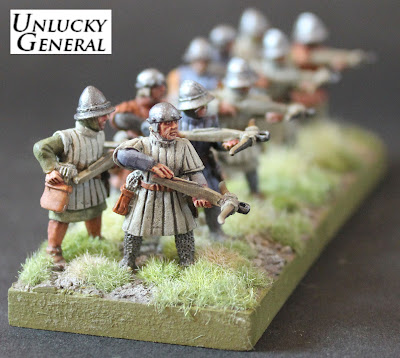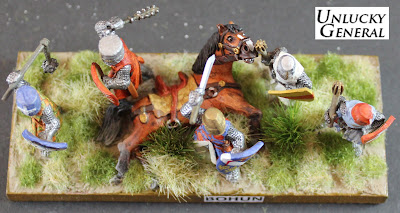John de Bracebridge: Research & Heraldy
 |
John de Bracebridge was born 1232, Kingsbury, Warwickshire and came into his inheritance (Kingsbury Manor) in July 1252 (aged 20). He deferred his knighthood; however, in 1256 for three years through the payment of fines (2 marks in gold) to the crown. It should be noted that this was in all probability a purely economic expedient for Bracebridge to avoid the knight’s fee and associated costs. It would appear that John was not the wealthiest of landholders.
He took up arms with the Montfortians in 1263/4 (48th year of Henry’s reign) and was at the siege of Northampton with Simon de Montfort (the younger) at its fall. As a direct result, John is recorded as having been confined at Shrewsbury, imprisoned there by Hugh de Tuberville for ransom. He secured his release (either from entering into some recognizance, parole or payment of ransom) but from this point the record is both sketchy and inconsistent. We do not know when or under what conditions John was released.

John Burke has him next with the younger Simon de Montfort at the Isle of Axholme, Linconshire where the ‘Disinherited’ barons (following the fall of Kenilworth, December 1266) were to hold out against Prince Edward. The so called Isle of Axholme was a cluster of communities on raised land among fens and tidal marshes, difficult to assault - similar to the Isle of Ely which the remaining ‘Disinherited’ similarly and unsuccessfully defended the following year. That makes for a two year gap in the Bracebridge record.
Peter Coss (Lordship, Knighthood and Locality, 1991) refers to it having been said that Bracebridge, “bore no arms against the King since Northampton nor aided the rebel cause” (p287). We are not told; however, where, when, by whom or in what circumstances this statement was allegedly made. Following Bourke, Coss accepts John Bracebridges’ adherence to Simon de Montfort the younger and his presence at Axholme; however, he also looks to the level of fines we presume Bracebridge owed the crown which was to financially ruin him, as we shall see later.
 The final fines for rebelling against the King were essentially fixed through the ‘Dictum of Kenilworth’ in 1266. Initially set at a ten times the value of a baron’s estate, this calculation was moderated to five times, or even less depending upon the degree of involvement of the subject knight. If Bracebridge was only involved at Northampton (as repeated in our tertiary sources) then the fines prior to the siege at Axholme should have been minimal – even as low as two years value or even one if he could prove he was ‘compelled’ to fight. The Dictum had been publicly declared and at a time where the baronial cause could not have looked more desperate. So then, why would Braebridge have pitched in with an obviously lost cause when it could only have made his situation worse?
The final fines for rebelling against the King were essentially fixed through the ‘Dictum of Kenilworth’ in 1266. Initially set at a ten times the value of a baron’s estate, this calculation was moderated to five times, or even less depending upon the degree of involvement of the subject knight. If Bracebridge was only involved at Northampton (as repeated in our tertiary sources) then the fines prior to the siege at Axholme should have been minimal – even as low as two years value or even one if he could prove he was ‘compelled’ to fight. The Dictum had been publicly declared and at a time where the baronial cause could not have looked more desperate. So then, why would Braebridge have pitched in with an obviously lost cause when it could only have made his situation worse? If this knight’s neutrality after Northampton was declared at all, I doubt its veracity and suspect it a claim to mollify his later judges. Rather, I believe that that John de Bracebridge never quit the younger Simon de Montfort’s side, most likely obtaining his release shortly after Northampton and taking to the field at Lewes with those who similarly broke faith with the terms of release. I further surmise that he stuck with young Simon’s army, missing Evesham and surviving to Axholme where he finally surrendered.
If this knight’s neutrality after Northampton was declared at all, I doubt its veracity and suspect it a claim to mollify his later judges. Rather, I believe that that John de Bracebridge never quit the younger Simon de Montfort’s side, most likely obtaining his release shortly after Northampton and taking to the field at Lewes with those who similarly broke faith with the terms of release. I further surmise that he stuck with young Simon’s army, missing Evesham and surviving to Axholme where he finally surrendered.Through his fines (and who knows, perhaps even a ransom) John appears to have been impoverished and lost physical control of his estates due to his inability to sustain payments. He resorted to leasing almost his entire holdings to Robert de Tybetot; by March 1269 Tybetot had gained the right of ‘free warren’ (unlimited hunting rights) of Kingsbury and by November life long demesne of it. Whilst he was never a wealthy knight (evidenced by his deferment of knighthood) these financial difficulties went on for eight years which suggests John de Bracebridge bore more than just a year or twos worth of fines. I think he was fined heavily because he was committed heavily to the baronial cause.
John de Bracebridge did not recover himself financially for the rest of his days, ending for him in 1274 in Kingsbury (aged 42), succeeded by his son, John de Bracebridge.
 Modelling: My John de Bracebridge is a Mirliton figure straight of their production line. I have given him yet another very plain cloth surcoat in an attempt to reflect his relatively humble means and I have given him the white cross field sign, sewn front and back to mark him as a Montfortian rebel. I have given him a heraldic caparison with a simple repetition pattern of his azure cross in small. The colour of the cloth is hopefully recognisably muted compared to the pigment on the shield.
Modelling: My John de Bracebridge is a Mirliton figure straight of their production line. I have given him yet another very plain cloth surcoat in an attempt to reflect his relatively humble means and I have given him the white cross field sign, sewn front and back to mark him as a Montfortian rebel. I have given him a heraldic caparison with a simple repetition pattern of his azure cross in small. The colour of the cloth is hopefully recognisably muted compared to the pigment on the shield.Selected References:
LF Salzman, The Victoria History of the County of Warwick
John Burke, Genealogical and Heraldic History of the Commoners of Great Britain and Ireland (Vol 1)
Sir William Dugdale, History of Embanking and Draining (1662)
Peter Coss, Lordship, Knighthood and Locality: A study in English Society 1180-1280 (1991)
'Parishes: Kingsbury', A History of the County of Warwick: Volume 4: Hemlingford Hundred (1947)
Open source: Geneology freepages
I'd also like to recognise Genuki whose county map is featured in this posting.



Comments
Sincerely,
D Norton